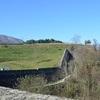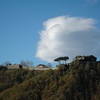Fort of Mont'Alfonso
The fortress, located on a hill near Castelnuovo Garfagnana, consists of a very large enclosed area (about 5200 square metres) with bastions, which allowed for the accommodation, if necessary, of people from the nearby villages. It was built using all of the techniques that were then considered cutting edge, beginning with the embankments which have been perfectly preserved over time.
Today Mont'Alfonso, with its sweeping lawns situated between the Renaissance bastions, is a favourite destination for those who love breathtaking views. The interior spaces are used by the community for cultural gatherings, concerts, conferences and various events. The fortress also houses a documentation centre on the fortifications of Garfagnana, with panels, films and replicas of weapons, allowing visitors to retrace the history of this historic military area on the border of many states.
Historical notes
On the high-ground situated to the west of Castelnuovo, a village had existed since very ancient times. Known as "Vellia" di Monti, its first mention in written records dates back to 991 and 1050. The village was first fortified in the Middle Ages. When Duke Alfonso II d'Este arrived in Garfagnana in 1561, the people dwelling near Castelnuovo requested the construction of a fortress that would give safe haven to those who lived in that area and would serve as an admonition and threat for the neighbouring state of Lucca. Two military architects Marco Antonio Pasi and Vincenzo Civitali were sent there, but it was not until 1578 that work of fortification of the high-ground began.
In the end, the project was taken over by Pasi alone because Civitali had too many relations with the Republic of Lucca. On 27 August 1579, work began on excavating the foundations of the imposing fortress ramparts and the work continued until 1585, the year of the last payment relating to the documented defence works.
The project called for earthworks, pentagonal bulwarks with "bowed" sides, platforms and technical devices like the "tail kite" shaped bastions. Pasi proved extremely capable in adapting the design according to the difficult nature of the soil, managing to not concede to the geometries imposed by treaties of military architecture of the time, but by refining the criteria to make this construction unique.
As soon as the defence works were completed, they were then equipped with large caliber artillery systems: these included four cannons, four falcon cannons and nearly 5,500 cannon balls. Once the area had been made secure, work began on the construction of the internal works, using the existing structures in the village of Monti.
For centuries, the Mont'Alfonso fortress, which owed its name to the union of the ancient name of the village with that of the Duke who had promoted it, played its role of territorial control and protection of the surrounding population with grim determination.
Once the reasons for friction between the Este State and the Republic of Lucca had ceased, the fort began to lose importance. The area was gradually demilitarised, the armed square was reduced to vegetable gardens and embankments were invaded by trees and vines. Even the fortress, once the last bastion of defence for the town of Monti, lost its military connotation and was transformed into a prison; many buildings were abandoned and collapsed, as happened to the foundry for cannons built in 1617, archaeological traces of which were recently found.











